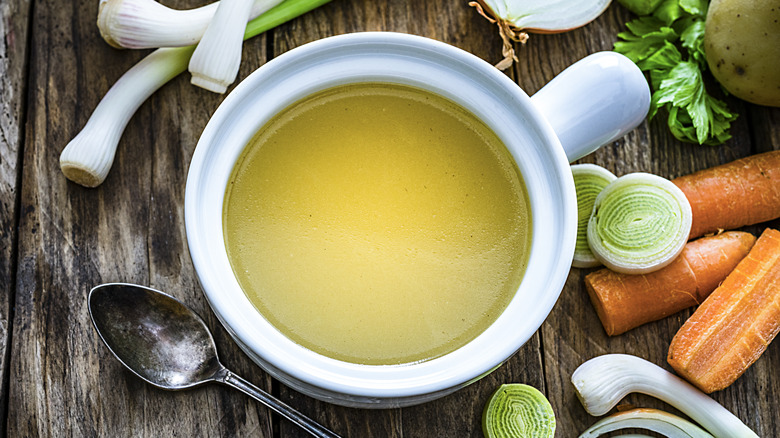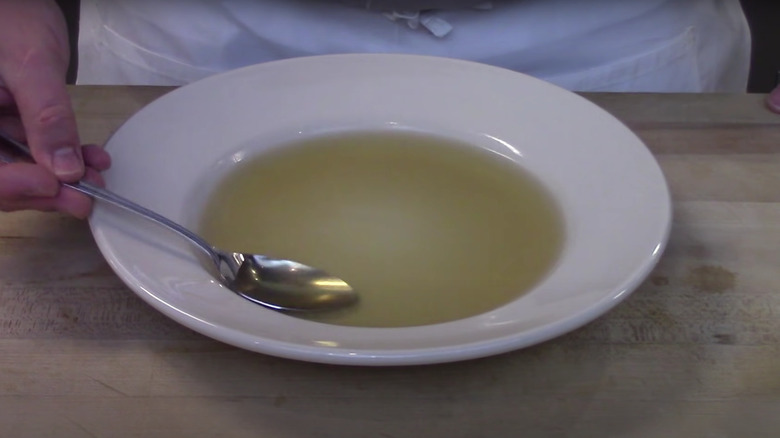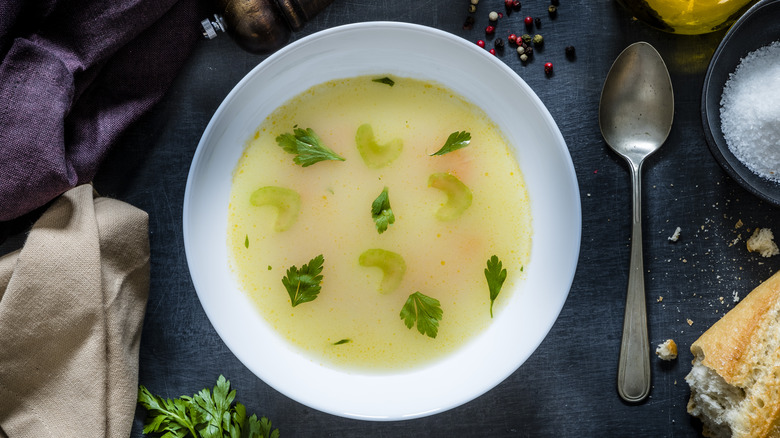What's The Difference Between Broth And Consommé?
Sometimes, we just crave something light, warm, comforting, delicious, and nutritious. Few things fit the bill like a steaming bowl of chicken broth –– or is that consommé? It's easy to confuse the two culinary cousins, as they're both edible, craveable hot liquids with legendary feel-good status.
Many a sore throat or queasy belly have yearned for chicken broth — and its purported healing effects. According to WebMD, it's not just psychological, as broth enhances hydration when sick and carries the potential for clearing stuffy noses and soothing sore throats. When used to create a veggie- and protein-filled soup, broth expands its superpowers with infusions of antioxidants and health-enhancing vitamins. Ditto for consommé, which arguably carries even more goodness into your body and your psyche.
Broth and consommé harbor similar attributes and ingredients but diverge in significant ways. A broth emerges when water and a primary ingredient, such as chicken, beef, fish, wild game, or vegetables, simmer gently, extracting flavor into the water. The resulting broth routinely serves as a base for soups, stews, and gravies, and it's rarely consumed on its own.
Consommé, on the other hand, is generally a standalone soup, often served at the beginning of a meal. Rather than building in a water base, it begins with an existing bone broth or stock, typically and preferably a homemade one. That means its essence has already been pulled from animal bones and tissues, which carry collagen and connective tissues. It's then clarified until perfectly clear.
Creating and clarifying consommé
While broth appears cloudy, consommé is generally clear and pristine. That's because it goes through a detailed process of clarification, leaving a richly flavored, filtered soup that's ready to eat. It requires no fancy kitchen gadgets to make it from scratch, instead relying crucially on egg whites.
Some chefs use egg whites alone to clarify consommé while others create a blended paste using egg whites and aromatic flavor-inducing ingredients like ground meats, vegetables, and herbs such as bay leaves, parsley, or thyme. When pouring the mixture into the base of hot stock or bone broth, the eggs congeal, grabbing impurities and causing it all to rise to the top of the pot. The covering is often called a raft as it floats atop the bubbling brew.
Creating a small hole in the middle of the raft keeps it intact and helps steam escape. Since all the cloudy bits and impurities stick to your raft, serving as a filter, you end up with a pure, delectable, clear, and nutritious consommé that rivals that of the finest restaurants. Serve on its own as a light meal or appetizer, adding diced vegetables, tomatoes, spices, or pasta as desired. Be sure to slip in any extras toward the end of the cooking process to preserve those translucent qualities you worked so hard to achieve. Eat with a spoon, or more traditionally, sip it as a drink.
The simple art of homemade broth
Making a simple broth, rather than the more intricately constructed consommé, is a fairly straightforward process. Traditional broths employ cold water, seasonings, vegetables, and meat or fish to create a flavorful liquid. The ingredients come to an initial stovetop boil and then slowly simmer at a reduced heat for up to four hours, skimming the top periodically.
It's important to use uncooked meats, including the popular chicken or beef options, which impart juices as the mixture simmers. If at all possible, use bone-in and skin-on pieces to ensure full flavor. You'll eventually find your own sweet spot of vegetables and herbs, but go-to additions for many people include carrots, celery, onions, bay leaves, garlic, thyme, parsley, whole peppercorns, and sometimes aromatics such as rosemary, sage, or thyme. You can slip the herbs straight into the water or, for easier removal later, bundle them in twine or wrap them in cheesecloth or a large tea bag. Add salt as desired.
Using about two quarts of water in a large stockpot typically results in six-plus cups of broth, depending on how long you let it simmer and concentrate. Remove the bits and pieces from your fresh homemade, delicious broth, and use them for other recipes as appropriate. It's a fantastic base for chicken noodle soup or made into classic giblet gravy for your roast dinner.
It's worth mentioning another member of the broth-consommé family clan, as the three are often confused. Stock is similar to broth, but it's generally cooked slower and longer, and the bones can be oven-roasted first for extra collagen extraction and flavor depth.



